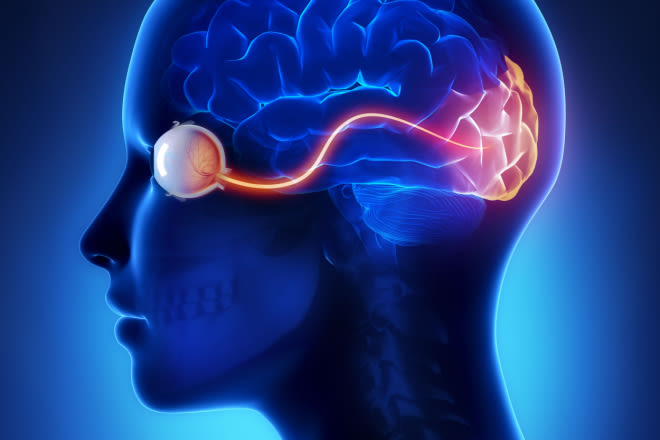Akinetopsia

What is akinetopsia?
Akinetopsia is a rare neuropsychological condition characterized by motion blindness. It affects a person’s ability to perceive motion within their visual field. Some people with akinetopsia see things in stop-action motion. For others, objects may seem to vanish and then reappear.
Normal motion perception allows the brain to recognize when objects are in motion. When akinetopsia occurs, this perception has been disrupted. Akinetopsia is a type of visual agnosia. It is a visual processing disorder (a condition that affects how the brain processes what a person sees). This means the brain has trouble understanding the information taken in through the eyes. Motion blindness may occur in varying degrees.
The word akinetopsia comes from the Greek language. A means “not,” kine refers to “move” and opsia translates to “see.” It is an acquired condition, which means it isn't inherited or present at birth. It can occur when the visual processing area of the brain is damaged.
Motion blindness can impact an individual's ability to complete day-to-day activities, such as:
Cooking
Reading
Playing sports
Watching television
Driving
In some cases, the effects may be mild and not interfere with routine activities. Individuals with motion blindness can usually still see stationary objects.
Types of akinetopsia
Akinetopsia is classified based on the severity of the condition and its effects on motion perception. Two primary forms have been identified.
Frozen frames
This form of akinetopsia is referred to as cinematographic vision or inconspicuous akinetopsia. Individuals with cinematographic vision see motion like a movie reel as if freezing frame by frame. Strobe-like effects may also occur. It is the least severe and most common type of the condition.
Vanishing objects
The second form of akinetopsia, also known as gross akinetopsia, is more severe and refers to the invisibility of moving objects. It involves the complete inability to perceive motion. Objects may seem to vanish once they move. Gross akinetopsia is extremely rare.
Akinetopsia vs. Zeitraffer phenomenon
Zeitraffer phenomenon is a condition similar to akinetopsia that affects motion perception. It impairs the brain’s ability to determine the speed at which objects in the visual field are moving. With this condition, objects may appear to move in slow motion.
Symptoms
Akinetopsia symptoms vary among individuals and the severity of the condition. People with motion blindness may experience one or more of the following:
Objects that freeze in motion
Objects that seem to move frame by frame
Objects that still appear when no longer in the visual field
Objects that vanish within the visual field
Difficulty tracking moving objects
Difficulty reaching for moving objects
Strobe-light effects
Complete motion blindness
In rare cases, severe visual impairment may occur. Damage to the eye is generally not observed.
Complete motion blindness only develops in cases of bilateral brain damage. Milder cases usually occur with unilateral damage.
People with akinetopsia must often rely on their hearing instead of visual function.
Motion blindness causes
Akinetopsia is caused by damage to a certain area of the brain known as the cerebral cortex. As such, it is also referred to as cerebral akinetopsia.
Within the cerebral cortex lies the visual cortex, located in the back of the head. The visual cortex processes visual details provided by the retina. It is categorized into five elements. V5 is the portion responsible for processing visual-spatial motion perception.

It is believed that damage to the V5 portion of the visual cortex is the cause of akinetopsia. Most cases of akinetopsia are due to bilateral brain damage. However, it may also result when only one side of the brain is damaged.
Several factors may increase the risk of brain damage or lead to motion blindness:
Brain tumors
Epilepsy
Neurodegenerative diseases (such as Alzheimer’s disease)
Hallucinogen persistent perception disorder (HPPD)
Post-concussive syndrome (PCS)
Adverse effects of medication
Transcranial magnetic stimulation (TMS)
As it is a very rare condition, there are few documented cases of akinetopsia. It may affect people of all ages, races and ethnicities. Males and females are affected equally.
SEE RELATED: How does the brain control eyesight?
Diagnosis
Akinetopsia is diagnosed through a neuro-ophthalmic examination and medical history review. Simple tests may be used to assess an individual’s ability to perceive motion. This might include throwing an object in the air and asking the patient to describe the object in motion. A diagnosis may be based on symptoms and a history of factors that might have caused the condition. Such factors may include trauma, medications or other events.
Computed tomography (CT) and magnetic resonance imaging (MRI) may be conducted to rule out other conditions. Further tests might be performed to detect underlying conditions that could be causing motion blindness.
Treatment
Akinetopsia can be challenging to address. There is no identified cure or effective treatment for the condition at this time. No medications have been approved for the treatment of akinetopsia. Treatment generally centers on the underlying condition or factors that caused motion blindness.
The prognosis of akinetopsia varies among individuals and the severity of symptoms.
Complications
Akinetopsia can be life-changing and impact a person’s day-to-day living in many ways. It can interfere with the ability to perform routine functions, such as:
Preparing food
Performing job duties
Following conversations
Walking on or crossing streets
The impact of motion blindness may lead to emotional distress and a lower quality of life.
When to see a doctor
Any vision changes should be evaluated promptly by an optometrist or ophthalmologist. These eye specialists might partner with other medical professionals to address motion blindness.
A neuro-ophthalmologist may be involved in the diagnosis and treatment of akinetopsia. Neuro-ophthalmologists are physicians that diagnose and treat vision problems relating to the brain and nerves.
READ NEXT: Visual Perception: How it works and common disorders
Akinetopsia. DoveMed. February 2021.
Akinetopsia. EyeWiki. American Academy of Ophthalmology. March 2023.
Akinetopsia. Neuro-ophthalmology Virtual Education Library: NOVEL. Video. Spencer S. Eccles Health Sciences Library, University of Utah. April 2021.
Chapter 14 – Motion perception and its disorders. In Handbook of Clinical Neurology. April 2021.
Visual agnosia. Cleveland Clinic. July 2022.
The visual agnosias and related disorders. Journal of Neuro-Ophthalmology. September 2018.
Akinetopsia with achromatopsia due to focal epilepsy. Seizure – European Journal of Epilepsy. March 2019.
Neuroanatomy, visual cortex. StatPearls [Internet]. August 2023.
Stroke. Stanford Medicine. Accessed September 2023.
20 reasons to see an ophthalmologist. EyeSmart. American Academy of Ophthalmology. February 2023.
Ophthalmology subspecialists. EyeSmart. American Academy of Ophthalmology. February 2023.
Page published on Thursday, November 30, 2023
Page updated on Tuesday, December 5, 2023
Medically reviewed on Wednesday, October 4, 2023






